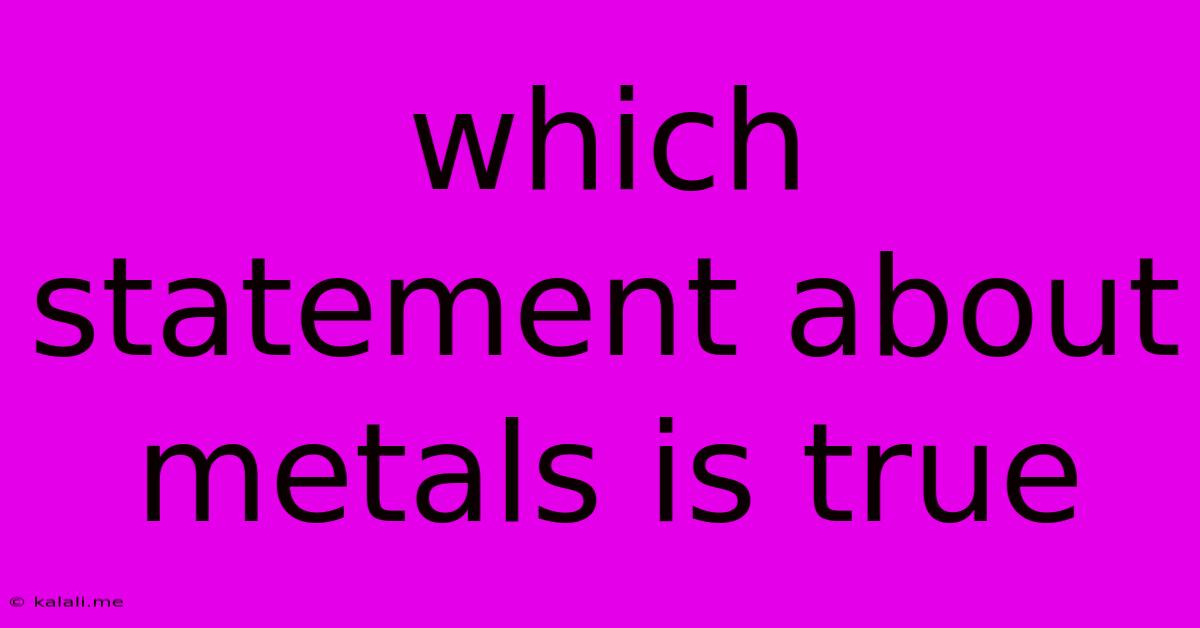Which Statement About Metals Is True
Kalali
Jun 16, 2025 · 3 min read

Table of Contents
Which Statement About Metals is True? A Comprehensive Guide
Meta Description: Unsure which statement about metals is true? This guide explores the key properties of metals, debunking common misconceptions and clarifying the characteristics that define these essential materials. Learn about conductivity, malleability, ductility, and more!
Metals are ubiquitous in our daily lives, from the smartphones in our pockets to the skyscrapers that define our cities. Understanding their properties is crucial in various fields, from engineering to chemistry. But with so many statements about metals floating around, it can be tricky to determine which ones are actually true. This article aims to clear up the confusion, examining common statements and identifying the accurate ones.
Key Properties of Metals: Separating Fact from Fiction
Many statements about metals revolve around their characteristic properties. Let's examine some of the most common:
-
Statement 1: Metals are good conductors of electricity and heat. This statement is true. The atomic structure of metals, with freely moving electrons in a "sea" of electrons, allows for efficient transfer of both electrical and thermal energy. This is why metals are used extensively in electrical wiring and cookware. This characteristic is directly related to their high electrical conductivity and thermal conductivity.
-
Statement 2: Metals are typically malleable and ductile. This statement is also true. Malleability refers to the ability of a metal to be hammered or rolled into thin sheets, while ductility refers to its ability to be drawn into wires. These properties are a direct result of the "sea of electrons" allowing metal atoms to slide past one another without breaking the metallic bond. Examples include gold being hammered into incredibly thin gold leaf and copper being drawn into thin wires.
-
Statement 3: All metals are shiny (lustrous). While many metals exhibit a characteristic shine or luster, this statement is not entirely true. Some metals, particularly when oxidized or in their compound form, can appear dull or lack the typical metallic sheen. The luster is a result of the interaction of light with the delocalized electrons, but this can be affected by surface conditions and chemical reactions.
-
Statement 4: Metals have high melting and boiling points. This statement is generally true, although there's variation among different metals. The strong metallic bonds require significant energy to overcome, resulting in higher melting and boiling points compared to non-metals. However, the specific melting and boiling points differ significantly depending on the metal; mercury, for example, is a liquid at room temperature.
-
Statement 5: Metals are always solid at room temperature. This statement is false. As mentioned previously, mercury is a liquid at room temperature, demonstrating that not all metals exist in a solid state under normal conditions. The physical state at room temperature is dependent on the strength of the metallic bonds and the atomic mass of the metal.
Beyond the Basics: Further Considerations
While the above statements cover fundamental properties, it's crucial to understand the nuances within the metal family. Factors like alloying (mixing metals) can significantly alter properties, creating materials with enhanced characteristics for specific applications. For example, stainless steel, an alloy of iron, chromium, and nickel, possesses superior corrosion resistance compared to pure iron.
The reactivity of metals also varies considerably. Some metals, like gold and platinum, are highly unreactive (noble metals), while others, such as sodium and potassium, are highly reactive and readily react with water. Understanding this reactivity is essential in applications ranging from jewelry-making to chemical reactions.
In conclusion, while many statements regarding metals hold true generally, it’s vital to consider the exceptions and nuances. Understanding the underlying atomic structure and bonding provides the key to comprehending the diverse properties exhibited by this important class of materials. This knowledge is fundamental for anyone working with or studying metals in any capacity.
Latest Posts
Latest Posts
-
Which Are Statements That Are True About Ecosystems
Jun 16, 2025
-
Select The Term With The Correct Spelling
Jun 16, 2025
-
If Qt Is Perpendicular To Pr
Jun 16, 2025
-
History Multiple Choice Questions And Answers Pdf
Jun 16, 2025
-
American University Of Paris Acceptance Rate For International Students
Jun 16, 2025
Related Post
Thank you for visiting our website which covers about Which Statement About Metals Is True . We hope the information provided has been useful to you. Feel free to contact us if you have any questions or need further assistance. See you next time and don't miss to bookmark.